Analyzing Total Quality Management Strategies for Events Companies
VerifiedAdded on 2021/04/17
|12
|3146
|58
Report
AI Summary
This report delves into the application of Total Quality Management (TQM) within the events sector, focusing on the practical implementation of TQM principles to enhance organizational success. It begins with an introduction to TQM, tracing its historical roots and defining its core concepts, including the approaches of Deming and Juran. The report then examines the usefulness, advantages, and limitations of TQM in the context of event management, emphasizing the importance of quality and how it can be measured through dimensions like tangibles, reliability, responsiveness, assurance, and empathy. A critical analysis follows, using The Events Company as a case study to illustrate how quality circles and benchmarking can drive organizational improvements. The report concludes by summarizing the key findings and implications for event companies seeking to optimize their operations and achieve higher levels of customer satisfaction. The report also highlights how TQM can lead to customer loyalty and enhance brand reputation, along with the challenges associated with its implementation. The analysis provides insights into how TQM can be used to meet customer expectations, remain competitive, and enhance business reputation.
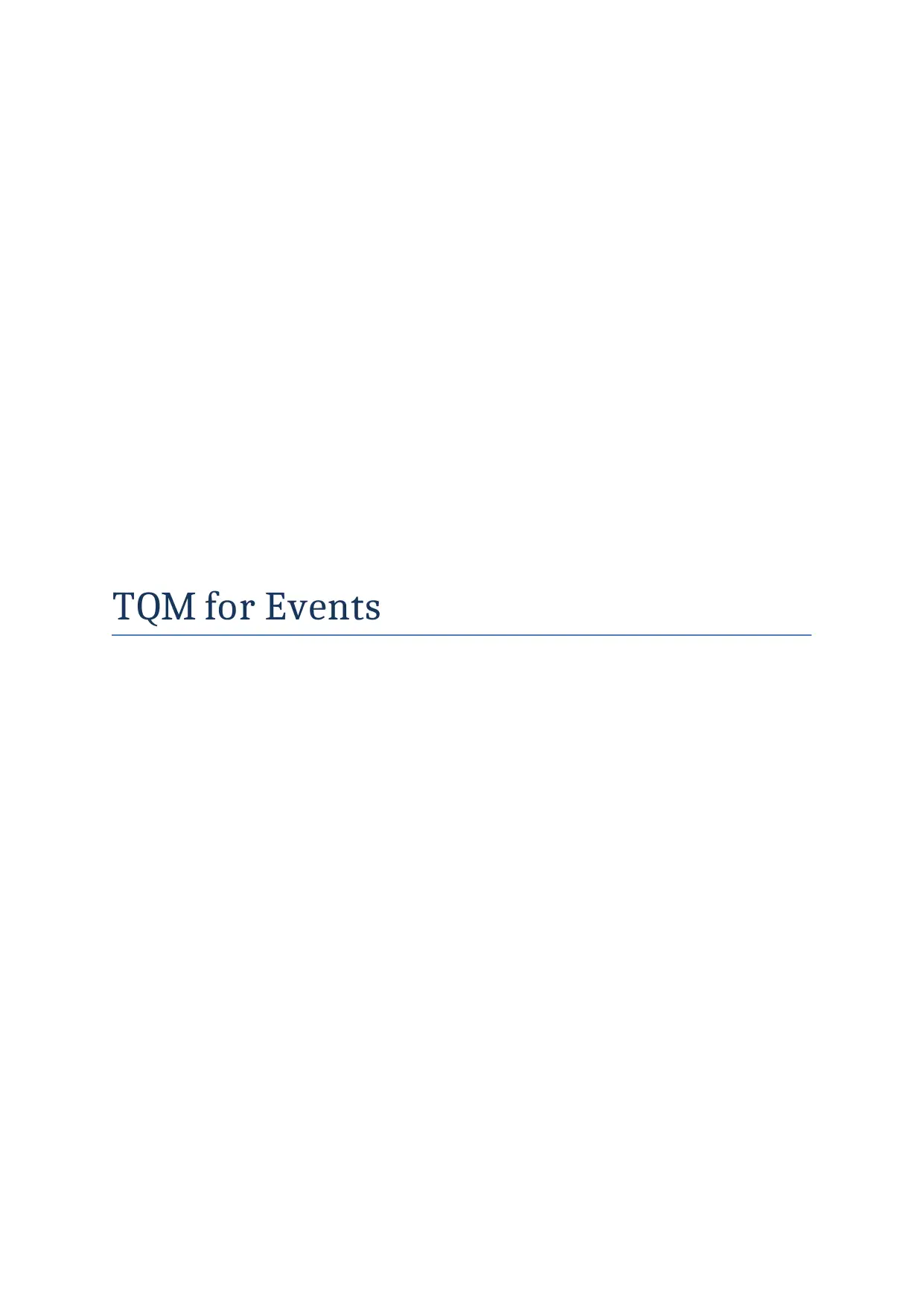
TQM for Events
Paraphrase This Document
Need a fresh take? Get an instant paraphrase of this document with our AI Paraphraser
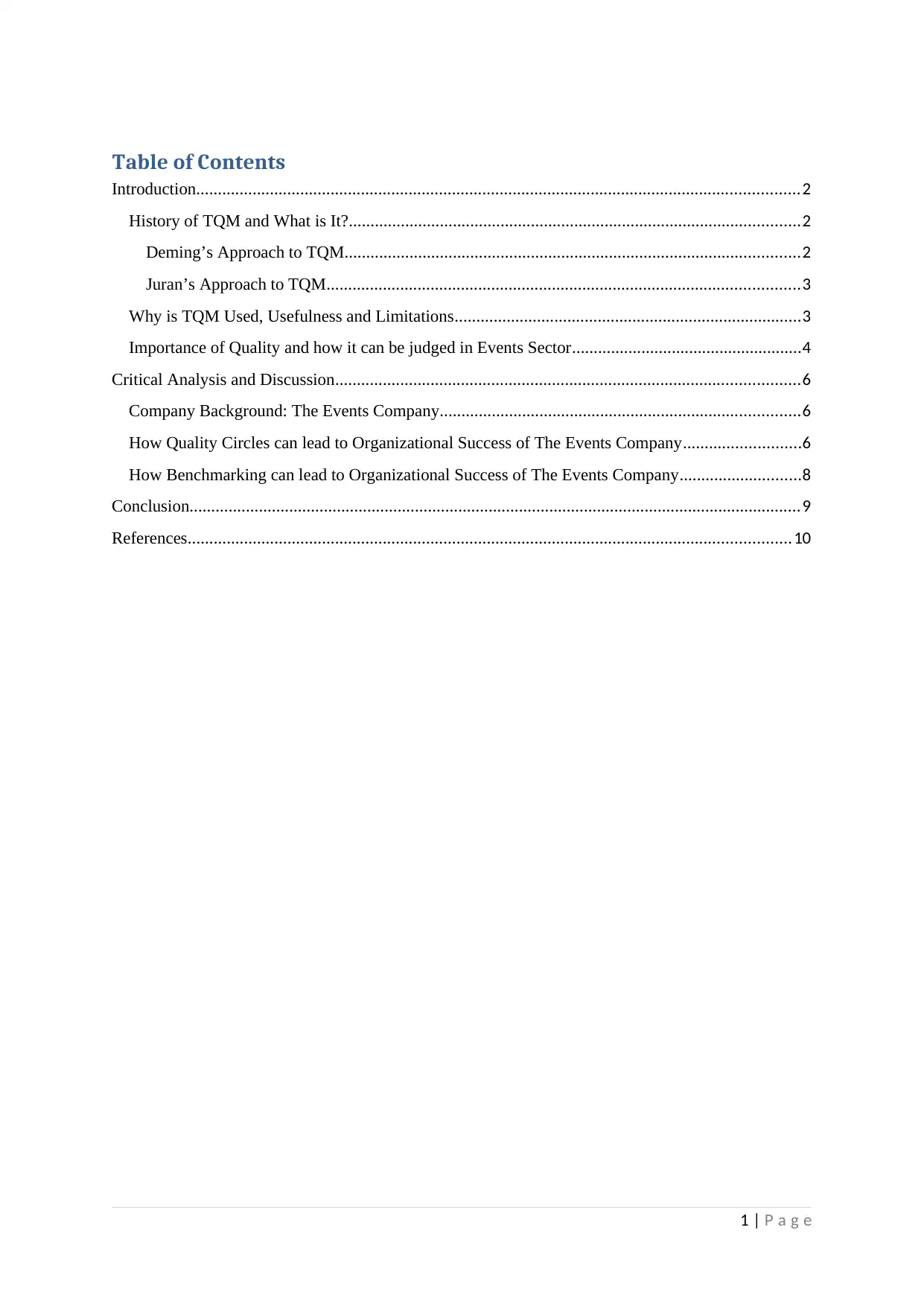
Table of Contents
Introduction...........................................................................................................................................2
History of TQM and What is It?........................................................................................................2
Deming’s Approach to TQM.........................................................................................................2
Juran’s Approach to TQM.............................................................................................................3
Why is TQM Used, Usefulness and Limitations................................................................................3
Importance of Quality and how it can be judged in Events Sector.....................................................4
Critical Analysis and Discussion...........................................................................................................6
Company Background: The Events Company...................................................................................6
How Quality Circles can lead to Organizational Success of The Events Company...........................6
How Benchmarking can lead to Organizational Success of The Events Company............................8
Conclusion.............................................................................................................................................9
References...........................................................................................................................................10
1 | P a g e
Introduction...........................................................................................................................................2
History of TQM and What is It?........................................................................................................2
Deming’s Approach to TQM.........................................................................................................2
Juran’s Approach to TQM.............................................................................................................3
Why is TQM Used, Usefulness and Limitations................................................................................3
Importance of Quality and how it can be judged in Events Sector.....................................................4
Critical Analysis and Discussion...........................................................................................................6
Company Background: The Events Company...................................................................................6
How Quality Circles can lead to Organizational Success of The Events Company...........................6
How Benchmarking can lead to Organizational Success of The Events Company............................8
Conclusion.............................................................................................................................................9
References...........................................................................................................................................10
1 | P a g e
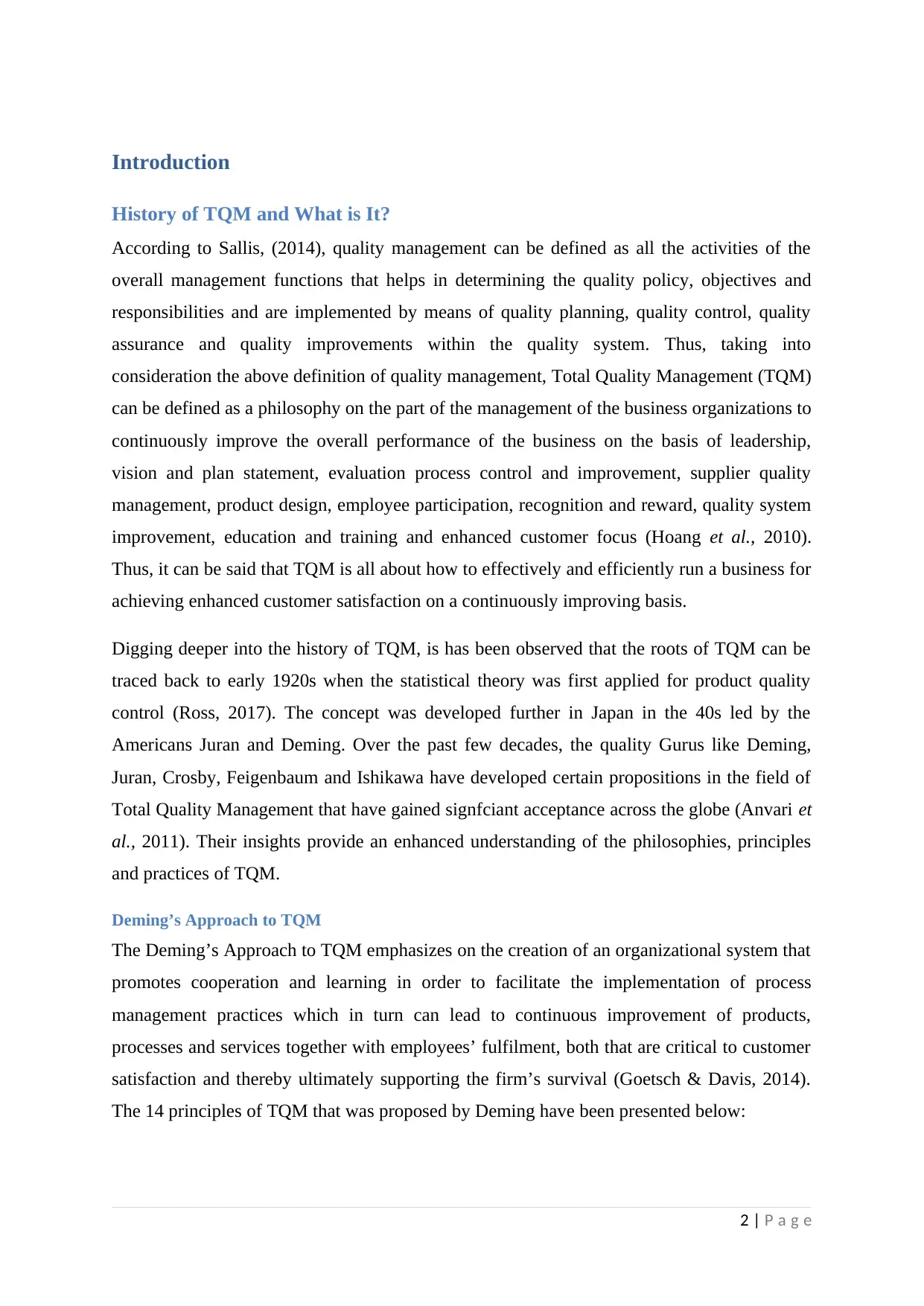
Introduction
History of TQM and What is It?
According to Sallis, (2014), quality management can be defined as all the activities of the
overall management functions that helps in determining the quality policy, objectives and
responsibilities and are implemented by means of quality planning, quality control, quality
assurance and quality improvements within the quality system. Thus, taking into
consideration the above definition of quality management, Total Quality Management (TQM)
can be defined as a philosophy on the part of the management of the business organizations to
continuously improve the overall performance of the business on the basis of leadership,
vision and plan statement, evaluation process control and improvement, supplier quality
management, product design, employee participation, recognition and reward, quality system
improvement, education and training and enhanced customer focus (Hoang et al., 2010).
Thus, it can be said that TQM is all about how to effectively and efficiently run a business for
achieving enhanced customer satisfaction on a continuously improving basis.
Digging deeper into the history of TQM, is has been observed that the roots of TQM can be
traced back to early 1920s when the statistical theory was first applied for product quality
control (Ross, 2017). The concept was developed further in Japan in the 40s led by the
Americans Juran and Deming. Over the past few decades, the quality Gurus like Deming,
Juran, Crosby, Feigenbaum and Ishikawa have developed certain propositions in the field of
Total Quality Management that have gained signfciant acceptance across the globe (Anvari et
al., 2011). Their insights provide an enhanced understanding of the philosophies, principles
and practices of TQM.
Deming’s Approach to TQM
The Deming’s Approach to TQM emphasizes on the creation of an organizational system that
promotes cooperation and learning in order to facilitate the implementation of process
management practices which in turn can lead to continuous improvement of products,
processes and services together with employees’ fulfilment, both that are critical to customer
satisfaction and thereby ultimately supporting the firm’s survival (Goetsch & Davis, 2014).
The 14 principles of TQM that was proposed by Deming have been presented below:
2 | P a g e
History of TQM and What is It?
According to Sallis, (2014), quality management can be defined as all the activities of the
overall management functions that helps in determining the quality policy, objectives and
responsibilities and are implemented by means of quality planning, quality control, quality
assurance and quality improvements within the quality system. Thus, taking into
consideration the above definition of quality management, Total Quality Management (TQM)
can be defined as a philosophy on the part of the management of the business organizations to
continuously improve the overall performance of the business on the basis of leadership,
vision and plan statement, evaluation process control and improvement, supplier quality
management, product design, employee participation, recognition and reward, quality system
improvement, education and training and enhanced customer focus (Hoang et al., 2010).
Thus, it can be said that TQM is all about how to effectively and efficiently run a business for
achieving enhanced customer satisfaction on a continuously improving basis.
Digging deeper into the history of TQM, is has been observed that the roots of TQM can be
traced back to early 1920s when the statistical theory was first applied for product quality
control (Ross, 2017). The concept was developed further in Japan in the 40s led by the
Americans Juran and Deming. Over the past few decades, the quality Gurus like Deming,
Juran, Crosby, Feigenbaum and Ishikawa have developed certain propositions in the field of
Total Quality Management that have gained signfciant acceptance across the globe (Anvari et
al., 2011). Their insights provide an enhanced understanding of the philosophies, principles
and practices of TQM.
Deming’s Approach to TQM
The Deming’s Approach to TQM emphasizes on the creation of an organizational system that
promotes cooperation and learning in order to facilitate the implementation of process
management practices which in turn can lead to continuous improvement of products,
processes and services together with employees’ fulfilment, both that are critical to customer
satisfaction and thereby ultimately supporting the firm’s survival (Goetsch & Davis, 2014).
The 14 principles of TQM that was proposed by Deming have been presented below:
2 | P a g e
⊘ This is a preview!⊘
Do you want full access?
Subscribe today to unlock all pages.

Trusted by 1+ million students worldwide
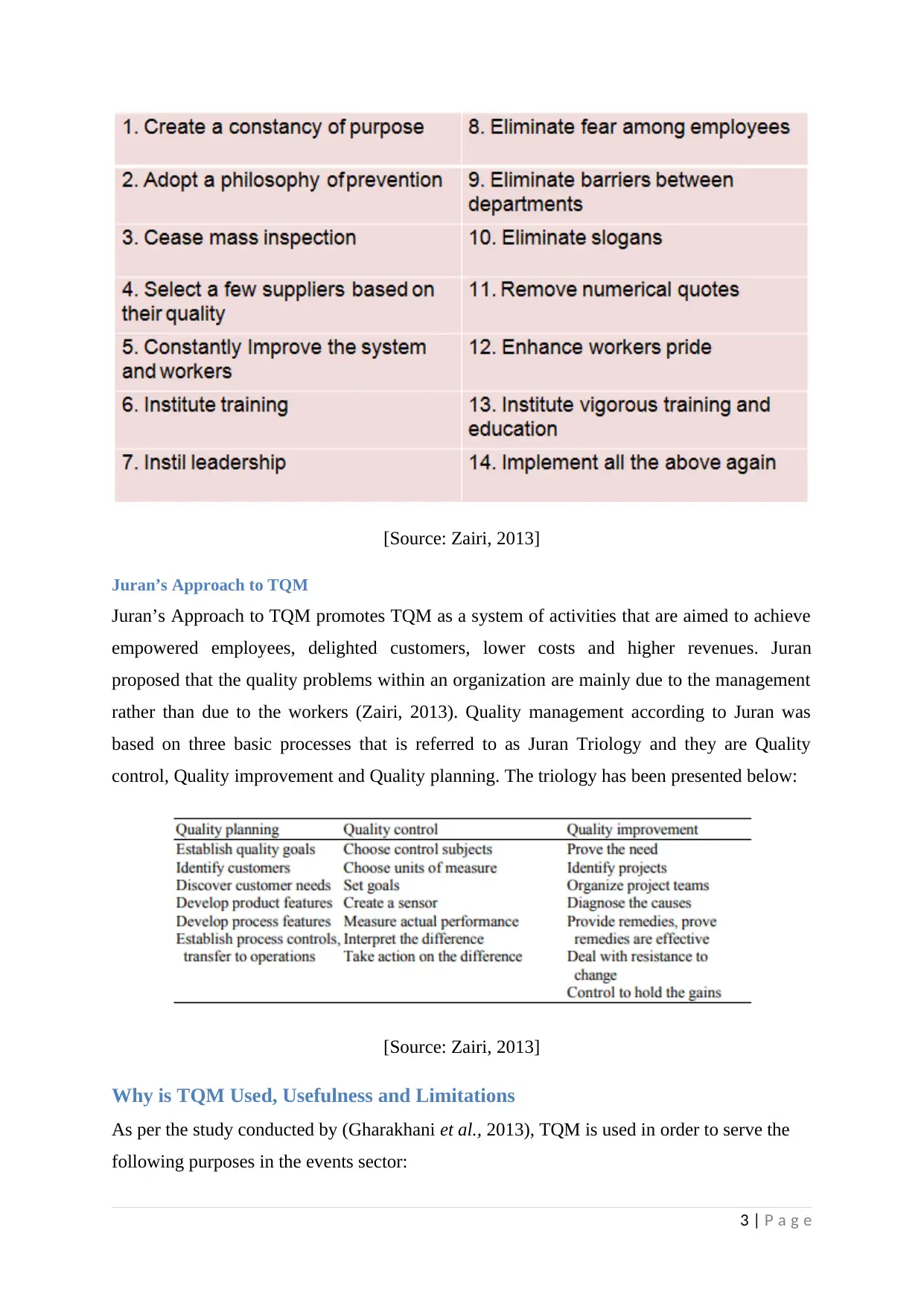
[Source: Zairi, 2013]
Juran’s Approach to TQM
Juran’s Approach to TQM promotes TQM as a system of activities that are aimed to achieve
empowered employees, delighted customers, lower costs and higher revenues. Juran
proposed that the quality problems within an organization are mainly due to the management
rather than due to the workers (Zairi, 2013). Quality management according to Juran was
based on three basic processes that is referred to as Juran Triology and they are Quality
control, Quality improvement and Quality planning. The triology has been presented below:
[Source: Zairi, 2013]
Why is TQM Used, Usefulness and Limitations
As per the study conducted by (Gharakhani et al., 2013), TQM is used in order to serve the
following purposes in the events sector:
3 | P a g e
Juran’s Approach to TQM
Juran’s Approach to TQM promotes TQM as a system of activities that are aimed to achieve
empowered employees, delighted customers, lower costs and higher revenues. Juran
proposed that the quality problems within an organization are mainly due to the management
rather than due to the workers (Zairi, 2013). Quality management according to Juran was
based on three basic processes that is referred to as Juran Triology and they are Quality
control, Quality improvement and Quality planning. The triology has been presented below:
[Source: Zairi, 2013]
Why is TQM Used, Usefulness and Limitations
As per the study conducted by (Gharakhani et al., 2013), TQM is used in order to serve the
following purposes in the events sector:
3 | P a g e
Paraphrase This Document
Need a fresh take? Get an instant paraphrase of this document with our AI Paraphraser
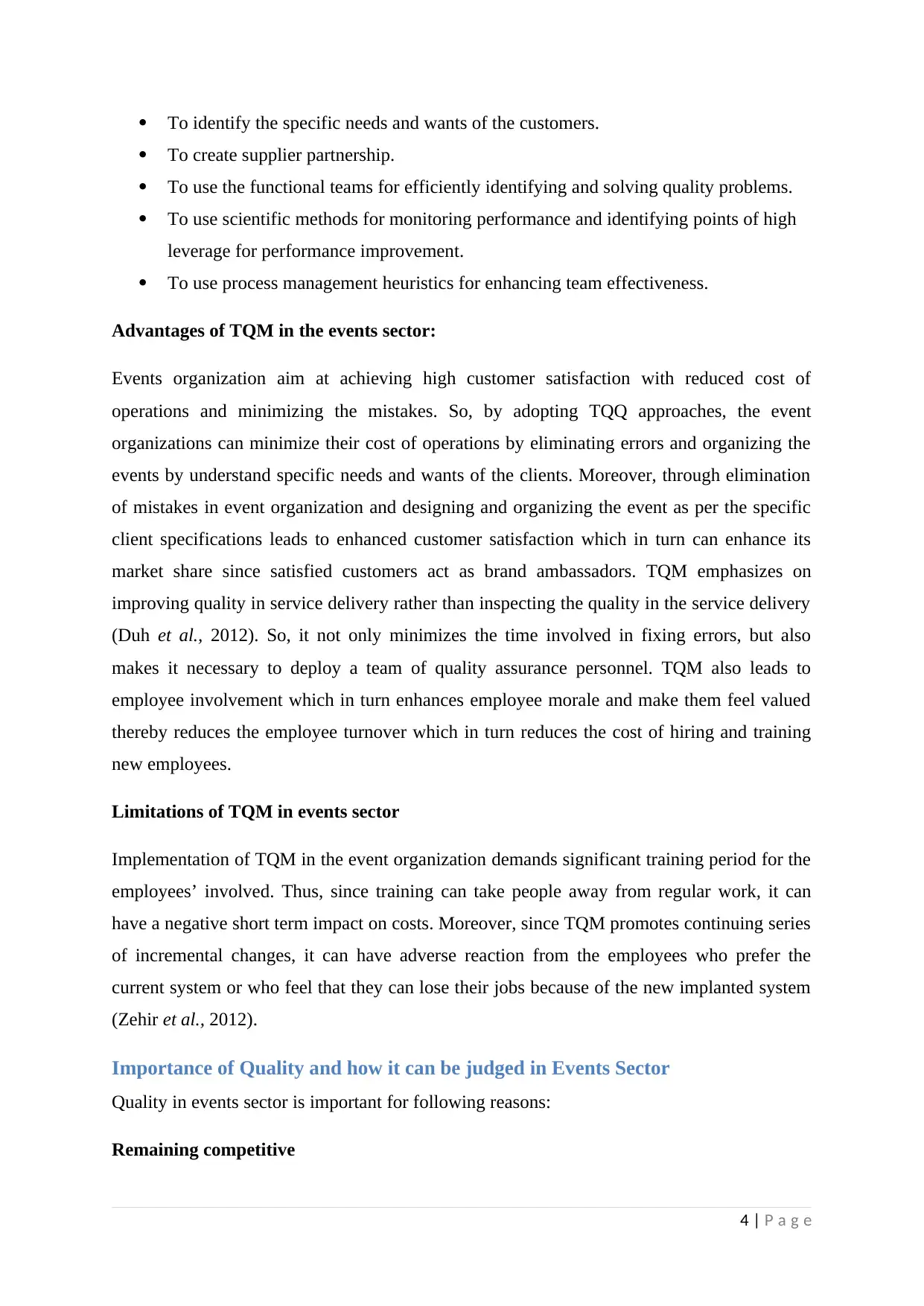
To identify the specific needs and wants of the customers.
To create supplier partnership.
To use the functional teams for efficiently identifying and solving quality problems.
To use scientific methods for monitoring performance and identifying points of high
leverage for performance improvement.
To use process management heuristics for enhancing team effectiveness.
Advantages of TQM in the events sector:
Events organization aim at achieving high customer satisfaction with reduced cost of
operations and minimizing the mistakes. So, by adopting TQQ approaches, the event
organizations can minimize their cost of operations by eliminating errors and organizing the
events by understand specific needs and wants of the clients. Moreover, through elimination
of mistakes in event organization and designing and organizing the event as per the specific
client specifications leads to enhanced customer satisfaction which in turn can enhance its
market share since satisfied customers act as brand ambassadors. TQM emphasizes on
improving quality in service delivery rather than inspecting the quality in the service delivery
(Duh et al., 2012). So, it not only minimizes the time involved in fixing errors, but also
makes it necessary to deploy a team of quality assurance personnel. TQM also leads to
employee involvement which in turn enhances employee morale and make them feel valued
thereby reduces the employee turnover which in turn reduces the cost of hiring and training
new employees.
Limitations of TQM in events sector
Implementation of TQM in the event organization demands significant training period for the
employees’ involved. Thus, since training can take people away from regular work, it can
have a negative short term impact on costs. Moreover, since TQM promotes continuing series
of incremental changes, it can have adverse reaction from the employees who prefer the
current system or who feel that they can lose their jobs because of the new implanted system
(Zehir et al., 2012).
Importance of Quality and how it can be judged in Events Sector
Quality in events sector is important for following reasons:
Remaining competitive
4 | P a g e
To create supplier partnership.
To use the functional teams for efficiently identifying and solving quality problems.
To use scientific methods for monitoring performance and identifying points of high
leverage for performance improvement.
To use process management heuristics for enhancing team effectiveness.
Advantages of TQM in the events sector:
Events organization aim at achieving high customer satisfaction with reduced cost of
operations and minimizing the mistakes. So, by adopting TQQ approaches, the event
organizations can minimize their cost of operations by eliminating errors and organizing the
events by understand specific needs and wants of the clients. Moreover, through elimination
of mistakes in event organization and designing and organizing the event as per the specific
client specifications leads to enhanced customer satisfaction which in turn can enhance its
market share since satisfied customers act as brand ambassadors. TQM emphasizes on
improving quality in service delivery rather than inspecting the quality in the service delivery
(Duh et al., 2012). So, it not only minimizes the time involved in fixing errors, but also
makes it necessary to deploy a team of quality assurance personnel. TQM also leads to
employee involvement which in turn enhances employee morale and make them feel valued
thereby reduces the employee turnover which in turn reduces the cost of hiring and training
new employees.
Limitations of TQM in events sector
Implementation of TQM in the event organization demands significant training period for the
employees’ involved. Thus, since training can take people away from regular work, it can
have a negative short term impact on costs. Moreover, since TQM promotes continuing series
of incremental changes, it can have adverse reaction from the employees who prefer the
current system or who feel that they can lose their jobs because of the new implanted system
(Zehir et al., 2012).
Importance of Quality and how it can be judged in Events Sector
Quality in events sector is important for following reasons:
Remaining competitive
4 | P a g e
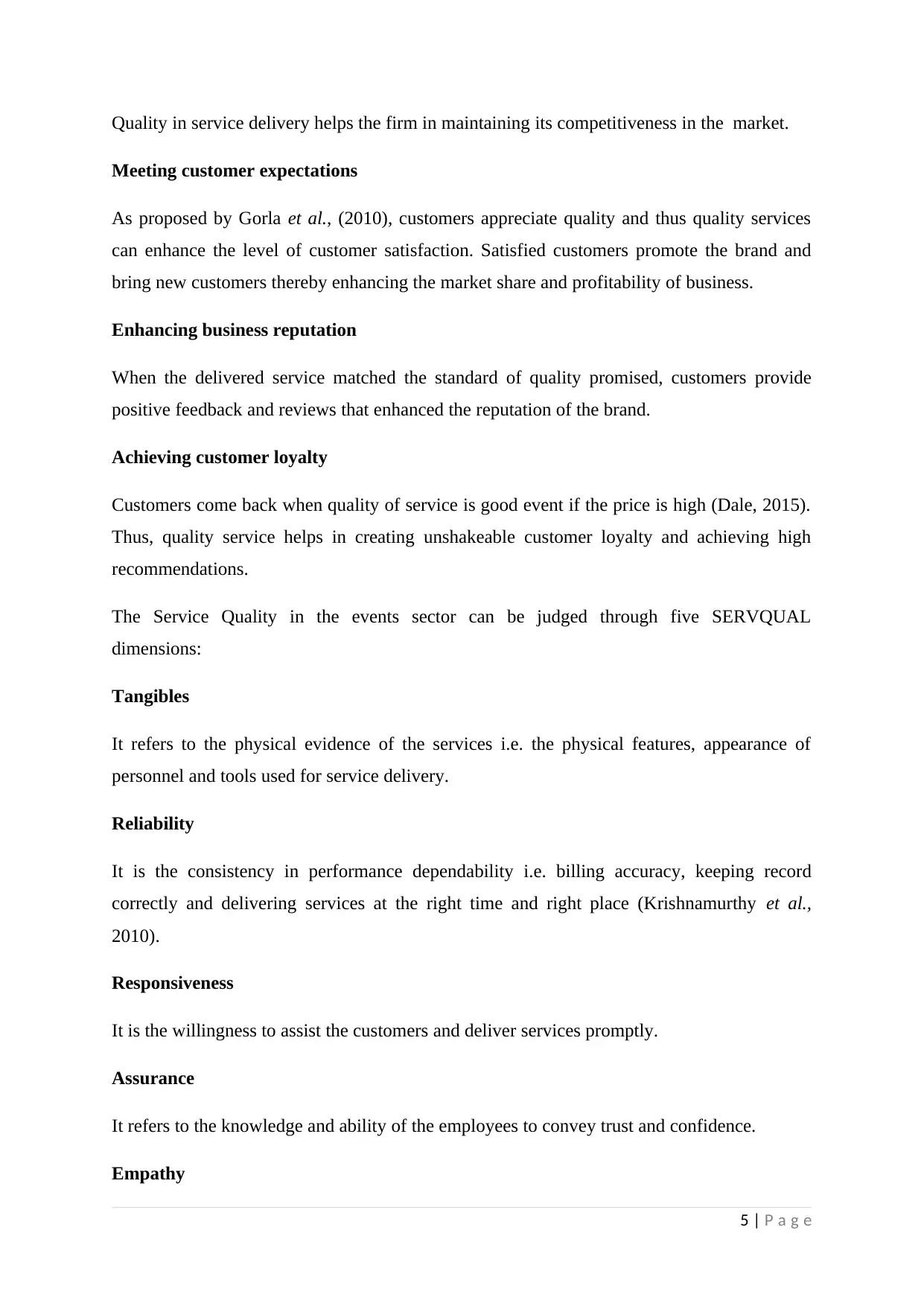
Quality in service delivery helps the firm in maintaining its competitiveness in the market.
Meeting customer expectations
As proposed by Gorla et al., (2010), customers appreciate quality and thus quality services
can enhance the level of customer satisfaction. Satisfied customers promote the brand and
bring new customers thereby enhancing the market share and profitability of business.
Enhancing business reputation
When the delivered service matched the standard of quality promised, customers provide
positive feedback and reviews that enhanced the reputation of the brand.
Achieving customer loyalty
Customers come back when quality of service is good event if the price is high (Dale, 2015).
Thus, quality service helps in creating unshakeable customer loyalty and achieving high
recommendations.
The Service Quality in the events sector can be judged through five SERVQUAL
dimensions:
Tangibles
It refers to the physical evidence of the services i.e. the physical features, appearance of
personnel and tools used for service delivery.
Reliability
It is the consistency in performance dependability i.e. billing accuracy, keeping record
correctly and delivering services at the right time and right place (Krishnamurthy et al.,
2010).
Responsiveness
It is the willingness to assist the customers and deliver services promptly.
Assurance
It refers to the knowledge and ability of the employees to convey trust and confidence.
Empathy
5 | P a g e
Meeting customer expectations
As proposed by Gorla et al., (2010), customers appreciate quality and thus quality services
can enhance the level of customer satisfaction. Satisfied customers promote the brand and
bring new customers thereby enhancing the market share and profitability of business.
Enhancing business reputation
When the delivered service matched the standard of quality promised, customers provide
positive feedback and reviews that enhanced the reputation of the brand.
Achieving customer loyalty
Customers come back when quality of service is good event if the price is high (Dale, 2015).
Thus, quality service helps in creating unshakeable customer loyalty and achieving high
recommendations.
The Service Quality in the events sector can be judged through five SERVQUAL
dimensions:
Tangibles
It refers to the physical evidence of the services i.e. the physical features, appearance of
personnel and tools used for service delivery.
Reliability
It is the consistency in performance dependability i.e. billing accuracy, keeping record
correctly and delivering services at the right time and right place (Krishnamurthy et al.,
2010).
Responsiveness
It is the willingness to assist the customers and deliver services promptly.
Assurance
It refers to the knowledge and ability of the employees to convey trust and confidence.
Empathy
5 | P a g e
⊘ This is a preview!⊘
Do you want full access?
Subscribe today to unlock all pages.

Trusted by 1+ million students worldwide
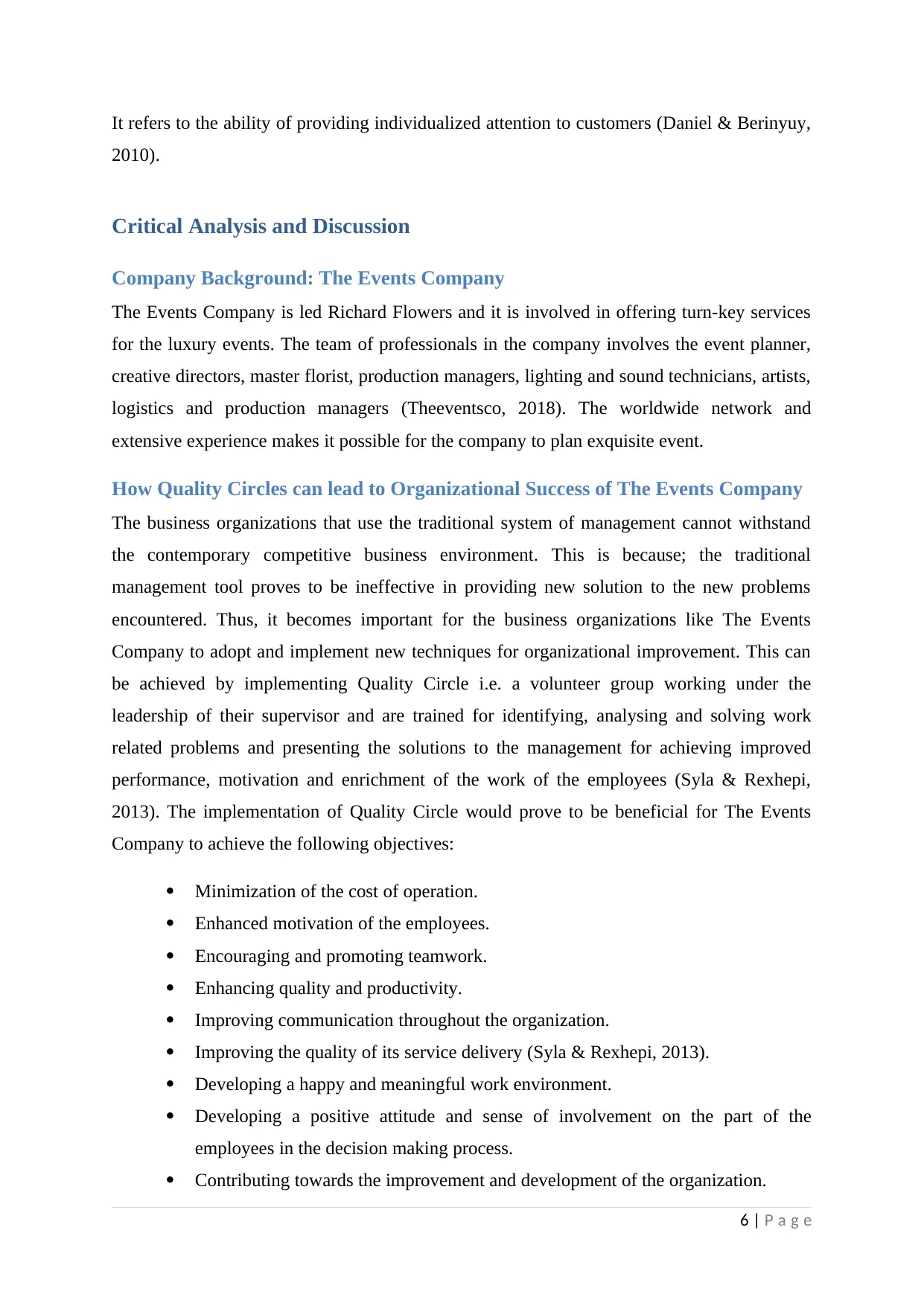
It refers to the ability of providing individualized attention to customers (Daniel & Berinyuy,
2010).
Critical Analysis and Discussion
Company Background: The Events Company
The Events Company is led Richard Flowers and it is involved in offering turn-key services
for the luxury events. The team of professionals in the company involves the event planner,
creative directors, master florist, production managers, lighting and sound technicians, artists,
logistics and production managers (Theeventsco, 2018). The worldwide network and
extensive experience makes it possible for the company to plan exquisite event.
How Quality Circles can lead to Organizational Success of The Events Company
The business organizations that use the traditional system of management cannot withstand
the contemporary competitive business environment. This is because; the traditional
management tool proves to be ineffective in providing new solution to the new problems
encountered. Thus, it becomes important for the business organizations like The Events
Company to adopt and implement new techniques for organizational improvement. This can
be achieved by implementing Quality Circle i.e. a volunteer group working under the
leadership of their supervisor and are trained for identifying, analysing and solving work
related problems and presenting the solutions to the management for achieving improved
performance, motivation and enrichment of the work of the employees (Syla & Rexhepi,
2013). The implementation of Quality Circle would prove to be beneficial for The Events
Company to achieve the following objectives:
Minimization of the cost of operation.
Enhanced motivation of the employees.
Encouraging and promoting teamwork.
Enhancing quality and productivity.
Improving communication throughout the organization.
Improving the quality of its service delivery (Syla & Rexhepi, 2013).
Developing a happy and meaningful work environment.
Developing a positive attitude and sense of involvement on the part of the
employees in the decision making process.
Contributing towards the improvement and development of the organization.
6 | P a g e
2010).
Critical Analysis and Discussion
Company Background: The Events Company
The Events Company is led Richard Flowers and it is involved in offering turn-key services
for the luxury events. The team of professionals in the company involves the event planner,
creative directors, master florist, production managers, lighting and sound technicians, artists,
logistics and production managers (Theeventsco, 2018). The worldwide network and
extensive experience makes it possible for the company to plan exquisite event.
How Quality Circles can lead to Organizational Success of The Events Company
The business organizations that use the traditional system of management cannot withstand
the contemporary competitive business environment. This is because; the traditional
management tool proves to be ineffective in providing new solution to the new problems
encountered. Thus, it becomes important for the business organizations like The Events
Company to adopt and implement new techniques for organizational improvement. This can
be achieved by implementing Quality Circle i.e. a volunteer group working under the
leadership of their supervisor and are trained for identifying, analysing and solving work
related problems and presenting the solutions to the management for achieving improved
performance, motivation and enrichment of the work of the employees (Syla & Rexhepi,
2013). The implementation of Quality Circle would prove to be beneficial for The Events
Company to achieve the following objectives:
Minimization of the cost of operation.
Enhanced motivation of the employees.
Encouraging and promoting teamwork.
Enhancing quality and productivity.
Improving communication throughout the organization.
Improving the quality of its service delivery (Syla & Rexhepi, 2013).
Developing a happy and meaningful work environment.
Developing a positive attitude and sense of involvement on the part of the
employees in the decision making process.
Contributing towards the improvement and development of the organization.
6 | P a g e
Paraphrase This Document
Need a fresh take? Get an instant paraphrase of this document with our AI Paraphraser
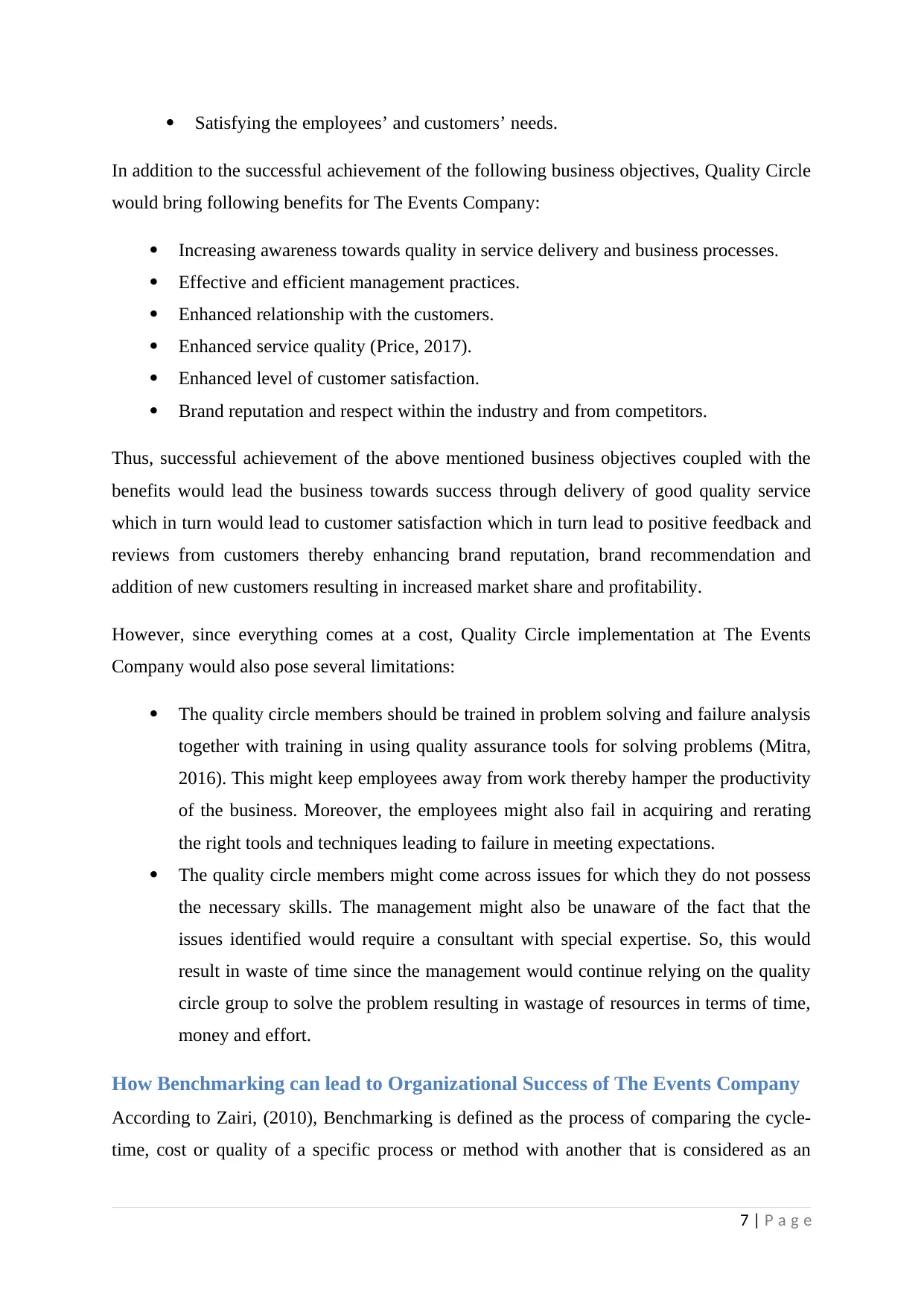
Satisfying the employees’ and customers’ needs.
In addition to the successful achievement of the following business objectives, Quality Circle
would bring following benefits for The Events Company:
Increasing awareness towards quality in service delivery and business processes.
Effective and efficient management practices.
Enhanced relationship with the customers.
Enhanced service quality (Price, 2017).
Enhanced level of customer satisfaction.
Brand reputation and respect within the industry and from competitors.
Thus, successful achievement of the above mentioned business objectives coupled with the
benefits would lead the business towards success through delivery of good quality service
which in turn would lead to customer satisfaction which in turn lead to positive feedback and
reviews from customers thereby enhancing brand reputation, brand recommendation and
addition of new customers resulting in increased market share and profitability.
However, since everything comes at a cost, Quality Circle implementation at The Events
Company would also pose several limitations:
The quality circle members should be trained in problem solving and failure analysis
together with training in using quality assurance tools for solving problems (Mitra,
2016). This might keep employees away from work thereby hamper the productivity
of the business. Moreover, the employees might also fail in acquiring and rerating
the right tools and techniques leading to failure in meeting expectations.
The quality circle members might come across issues for which they do not possess
the necessary skills. The management might also be unaware of the fact that the
issues identified would require a consultant with special expertise. So, this would
result in waste of time since the management would continue relying on the quality
circle group to solve the problem resulting in wastage of resources in terms of time,
money and effort.
How Benchmarking can lead to Organizational Success of The Events Company
According to Zairi, (2010), Benchmarking is defined as the process of comparing the cycle-
time, cost or quality of a specific process or method with another that is considered as an
7 | P a g e
In addition to the successful achievement of the following business objectives, Quality Circle
would bring following benefits for The Events Company:
Increasing awareness towards quality in service delivery and business processes.
Effective and efficient management practices.
Enhanced relationship with the customers.
Enhanced service quality (Price, 2017).
Enhanced level of customer satisfaction.
Brand reputation and respect within the industry and from competitors.
Thus, successful achievement of the above mentioned business objectives coupled with the
benefits would lead the business towards success through delivery of good quality service
which in turn would lead to customer satisfaction which in turn lead to positive feedback and
reviews from customers thereby enhancing brand reputation, brand recommendation and
addition of new customers resulting in increased market share and profitability.
However, since everything comes at a cost, Quality Circle implementation at The Events
Company would also pose several limitations:
The quality circle members should be trained in problem solving and failure analysis
together with training in using quality assurance tools for solving problems (Mitra,
2016). This might keep employees away from work thereby hamper the productivity
of the business. Moreover, the employees might also fail in acquiring and rerating
the right tools and techniques leading to failure in meeting expectations.
The quality circle members might come across issues for which they do not possess
the necessary skills. The management might also be unaware of the fact that the
issues identified would require a consultant with special expertise. So, this would
result in waste of time since the management would continue relying on the quality
circle group to solve the problem resulting in wastage of resources in terms of time,
money and effort.
How Benchmarking can lead to Organizational Success of The Events Company
According to Zairi, (2010), Benchmarking is defined as the process of comparing the cycle-
time, cost or quality of a specific process or method with another that is considered as an
7 | P a g e
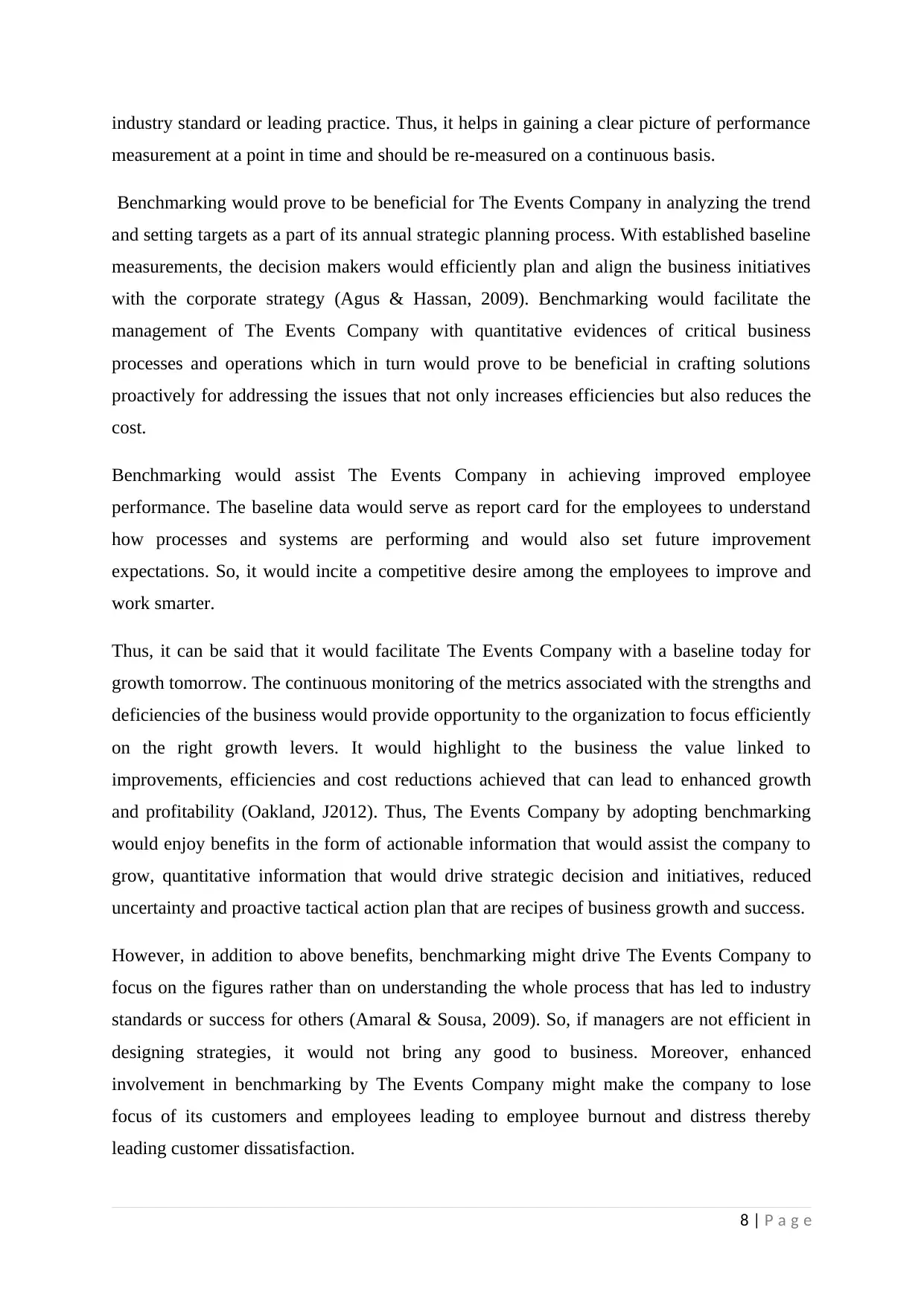
industry standard or leading practice. Thus, it helps in gaining a clear picture of performance
measurement at a point in time and should be re-measured on a continuous basis.
Benchmarking would prove to be beneficial for The Events Company in analyzing the trend
and setting targets as a part of its annual strategic planning process. With established baseline
measurements, the decision makers would efficiently plan and align the business initiatives
with the corporate strategy (Agus & Hassan, 2009). Benchmarking would facilitate the
management of The Events Company with quantitative evidences of critical business
processes and operations which in turn would prove to be beneficial in crafting solutions
proactively for addressing the issues that not only increases efficiencies but also reduces the
cost.
Benchmarking would assist The Events Company in achieving improved employee
performance. The baseline data would serve as report card for the employees to understand
how processes and systems are performing and would also set future improvement
expectations. So, it would incite a competitive desire among the employees to improve and
work smarter.
Thus, it can be said that it would facilitate The Events Company with a baseline today for
growth tomorrow. The continuous monitoring of the metrics associated with the strengths and
deficiencies of the business would provide opportunity to the organization to focus efficiently
on the right growth levers. It would highlight to the business the value linked to
improvements, efficiencies and cost reductions achieved that can lead to enhanced growth
and profitability (Oakland, J2012). Thus, The Events Company by adopting benchmarking
would enjoy benefits in the form of actionable information that would assist the company to
grow, quantitative information that would drive strategic decision and initiatives, reduced
uncertainty and proactive tactical action plan that are recipes of business growth and success.
However, in addition to above benefits, benchmarking might drive The Events Company to
focus on the figures rather than on understanding the whole process that has led to industry
standards or success for others (Amaral & Sousa, 2009). So, if managers are not efficient in
designing strategies, it would not bring any good to business. Moreover, enhanced
involvement in benchmarking by The Events Company might make the company to lose
focus of its customers and employees leading to employee burnout and distress thereby
leading customer dissatisfaction.
8 | P a g e
measurement at a point in time and should be re-measured on a continuous basis.
Benchmarking would prove to be beneficial for The Events Company in analyzing the trend
and setting targets as a part of its annual strategic planning process. With established baseline
measurements, the decision makers would efficiently plan and align the business initiatives
with the corporate strategy (Agus & Hassan, 2009). Benchmarking would facilitate the
management of The Events Company with quantitative evidences of critical business
processes and operations which in turn would prove to be beneficial in crafting solutions
proactively for addressing the issues that not only increases efficiencies but also reduces the
cost.
Benchmarking would assist The Events Company in achieving improved employee
performance. The baseline data would serve as report card for the employees to understand
how processes and systems are performing and would also set future improvement
expectations. So, it would incite a competitive desire among the employees to improve and
work smarter.
Thus, it can be said that it would facilitate The Events Company with a baseline today for
growth tomorrow. The continuous monitoring of the metrics associated with the strengths and
deficiencies of the business would provide opportunity to the organization to focus efficiently
on the right growth levers. It would highlight to the business the value linked to
improvements, efficiencies and cost reductions achieved that can lead to enhanced growth
and profitability (Oakland, J2012). Thus, The Events Company by adopting benchmarking
would enjoy benefits in the form of actionable information that would assist the company to
grow, quantitative information that would drive strategic decision and initiatives, reduced
uncertainty and proactive tactical action plan that are recipes of business growth and success.
However, in addition to above benefits, benchmarking might drive The Events Company to
focus on the figures rather than on understanding the whole process that has led to industry
standards or success for others (Amaral & Sousa, 2009). So, if managers are not efficient in
designing strategies, it would not bring any good to business. Moreover, enhanced
involvement in benchmarking by The Events Company might make the company to lose
focus of its customers and employees leading to employee burnout and distress thereby
leading customer dissatisfaction.
8 | P a g e
⊘ This is a preview!⊘
Do you want full access?
Subscribe today to unlock all pages.

Trusted by 1+ million students worldwide
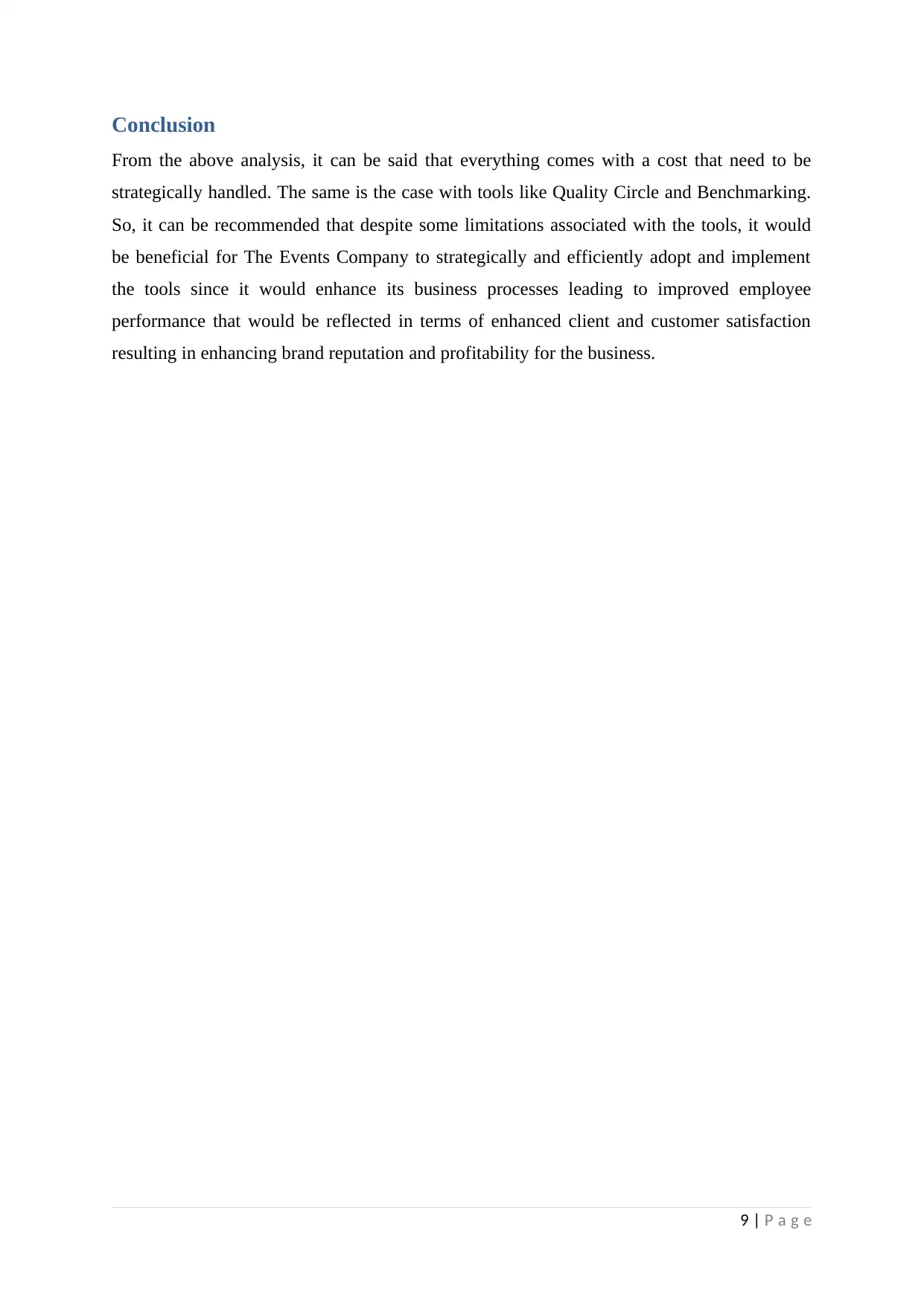
Conclusion
From the above analysis, it can be said that everything comes with a cost that need to be
strategically handled. The same is the case with tools like Quality Circle and Benchmarking.
So, it can be recommended that despite some limitations associated with the tools, it would
be beneficial for The Events Company to strategically and efficiently adopt and implement
the tools since it would enhance its business processes leading to improved employee
performance that would be reflected in terms of enhanced client and customer satisfaction
resulting in enhancing brand reputation and profitability for the business.
9 | P a g e
From the above analysis, it can be said that everything comes with a cost that need to be
strategically handled. The same is the case with tools like Quality Circle and Benchmarking.
So, it can be recommended that despite some limitations associated with the tools, it would
be beneficial for The Events Company to strategically and efficiently adopt and implement
the tools since it would enhance its business processes leading to improved employee
performance that would be reflected in terms of enhanced client and customer satisfaction
resulting in enhancing brand reputation and profitability for the business.
9 | P a g e
Paraphrase This Document
Need a fresh take? Get an instant paraphrase of this document with our AI Paraphraser
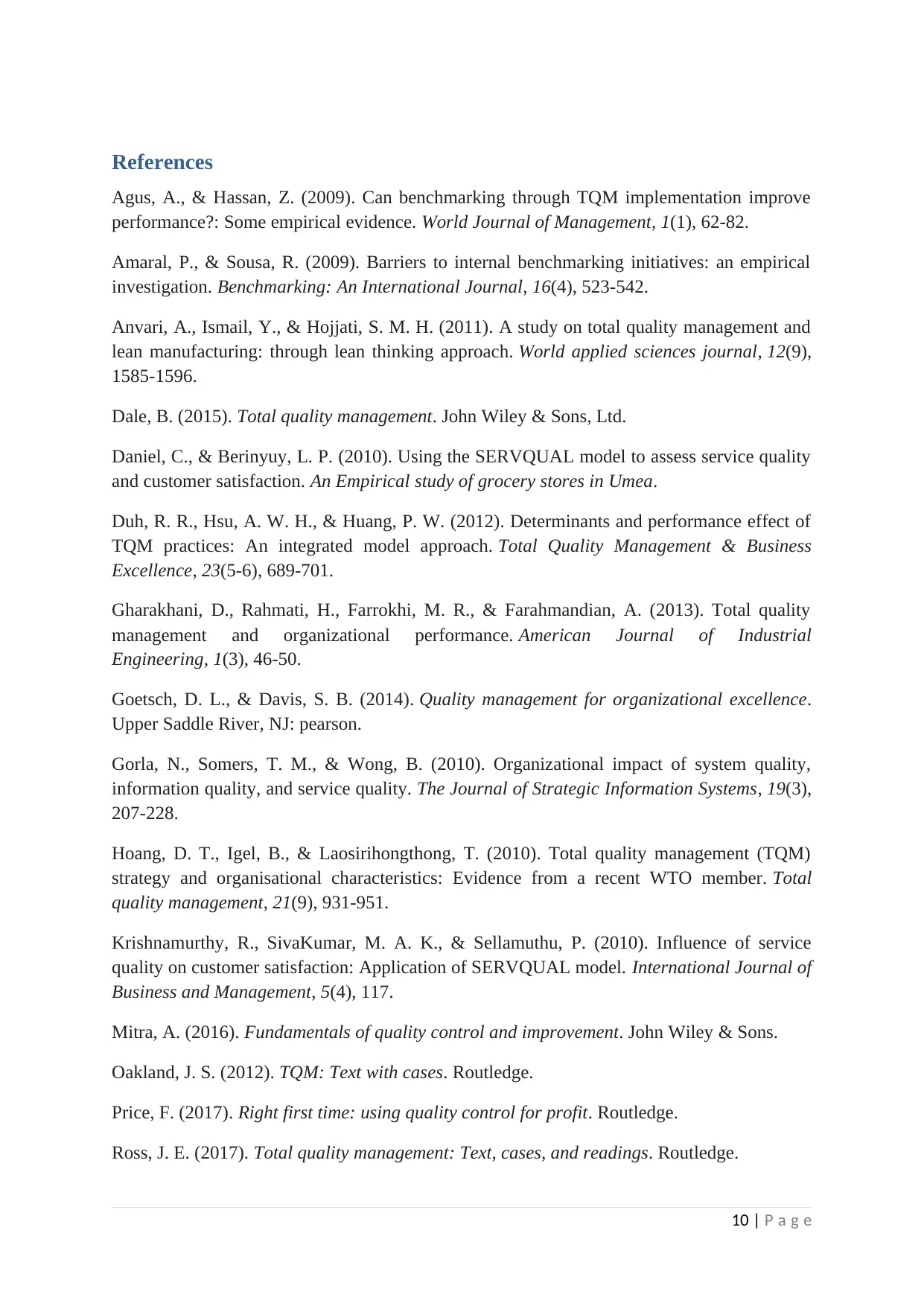
References
Agus, A., & Hassan, Z. (2009). Can benchmarking through TQM implementation improve
performance?: Some empirical evidence. World Journal of Management, 1(1), 62-82.
Amaral, P., & Sousa, R. (2009). Barriers to internal benchmarking initiatives: an empirical
investigation. Benchmarking: An International Journal, 16(4), 523-542.
Anvari, A., Ismail, Y., & Hojjati, S. M. H. (2011). A study on total quality management and
lean manufacturing: through lean thinking approach. World applied sciences journal, 12(9),
1585-1596.
Dale, B. (2015). Total quality management. John Wiley & Sons, Ltd.
Daniel, C., & Berinyuy, L. P. (2010). Using the SERVQUAL model to assess service quality
and customer satisfaction. An Empirical study of grocery stores in Umea.
Duh, R. R., Hsu, A. W. H., & Huang, P. W. (2012). Determinants and performance effect of
TQM practices: An integrated model approach. Total Quality Management & Business
Excellence, 23(5-6), 689-701.
Gharakhani, D., Rahmati, H., Farrokhi, M. R., & Farahmandian, A. (2013). Total quality
management and organizational performance. American Journal of Industrial
Engineering, 1(3), 46-50.
Goetsch, D. L., & Davis, S. B. (2014). Quality management for organizational excellence.
Upper Saddle River, NJ: pearson.
Gorla, N., Somers, T. M., & Wong, B. (2010). Organizational impact of system quality,
information quality, and service quality. The Journal of Strategic Information Systems, 19(3),
207-228.
Hoang, D. T., Igel, B., & Laosirihongthong, T. (2010). Total quality management (TQM)
strategy and organisational characteristics: Evidence from a recent WTO member. Total
quality management, 21(9), 931-951.
Krishnamurthy, R., SivaKumar, M. A. K., & Sellamuthu, P. (2010). Influence of service
quality on customer satisfaction: Application of SERVQUAL model. International Journal of
Business and Management, 5(4), 117.
Mitra, A. (2016). Fundamentals of quality control and improvement. John Wiley & Sons.
Oakland, J. S. (2012). TQM: Text with cases. Routledge.
Price, F. (2017). Right first time: using quality control for profit. Routledge.
Ross, J. E. (2017). Total quality management: Text, cases, and readings. Routledge.
10 | P a g e
Agus, A., & Hassan, Z. (2009). Can benchmarking through TQM implementation improve
performance?: Some empirical evidence. World Journal of Management, 1(1), 62-82.
Amaral, P., & Sousa, R. (2009). Barriers to internal benchmarking initiatives: an empirical
investigation. Benchmarking: An International Journal, 16(4), 523-542.
Anvari, A., Ismail, Y., & Hojjati, S. M. H. (2011). A study on total quality management and
lean manufacturing: through lean thinking approach. World applied sciences journal, 12(9),
1585-1596.
Dale, B. (2015). Total quality management. John Wiley & Sons, Ltd.
Daniel, C., & Berinyuy, L. P. (2010). Using the SERVQUAL model to assess service quality
and customer satisfaction. An Empirical study of grocery stores in Umea.
Duh, R. R., Hsu, A. W. H., & Huang, P. W. (2012). Determinants and performance effect of
TQM practices: An integrated model approach. Total Quality Management & Business
Excellence, 23(5-6), 689-701.
Gharakhani, D., Rahmati, H., Farrokhi, M. R., & Farahmandian, A. (2013). Total quality
management and organizational performance. American Journal of Industrial
Engineering, 1(3), 46-50.
Goetsch, D. L., & Davis, S. B. (2014). Quality management for organizational excellence.
Upper Saddle River, NJ: pearson.
Gorla, N., Somers, T. M., & Wong, B. (2010). Organizational impact of system quality,
information quality, and service quality. The Journal of Strategic Information Systems, 19(3),
207-228.
Hoang, D. T., Igel, B., & Laosirihongthong, T. (2010). Total quality management (TQM)
strategy and organisational characteristics: Evidence from a recent WTO member. Total
quality management, 21(9), 931-951.
Krishnamurthy, R., SivaKumar, M. A. K., & Sellamuthu, P. (2010). Influence of service
quality on customer satisfaction: Application of SERVQUAL model. International Journal of
Business and Management, 5(4), 117.
Mitra, A. (2016). Fundamentals of quality control and improvement. John Wiley & Sons.
Oakland, J. S. (2012). TQM: Text with cases. Routledge.
Price, F. (2017). Right first time: using quality control for profit. Routledge.
Ross, J. E. (2017). Total quality management: Text, cases, and readings. Routledge.
10 | P a g e
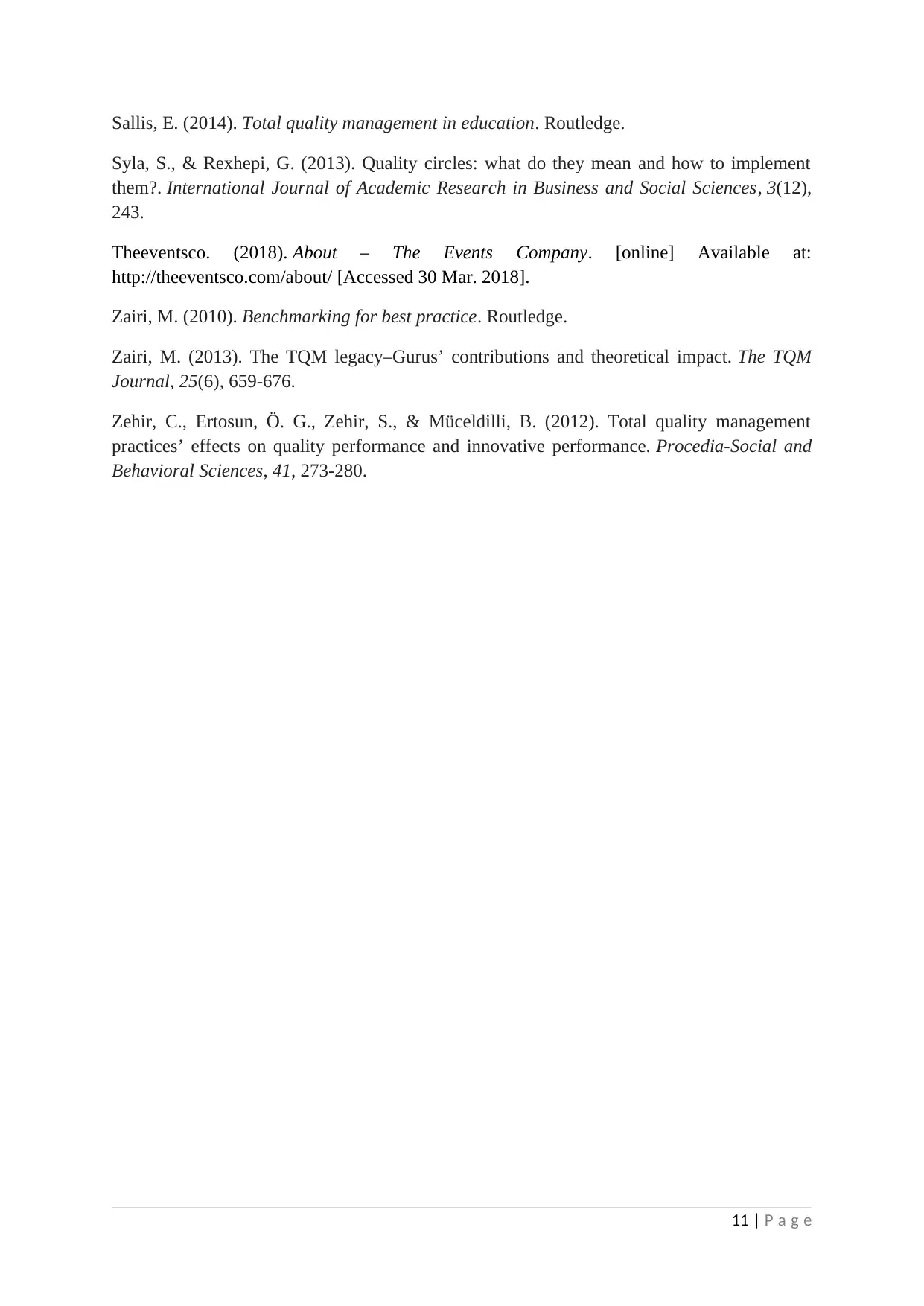
Sallis, E. (2014). Total quality management in education. Routledge.
Syla, S., & Rexhepi, G. (2013). Quality circles: what do they mean and how to implement
them?. International Journal of Academic Research in Business and Social Sciences, 3(12),
243.
Theeventsco. (2018). About – The Events Company. [online] Available at:
http://theeventsco.com/about/ [Accessed 30 Mar. 2018].
Zairi, M. (2010). Benchmarking for best practice. Routledge.
Zairi, M. (2013). The TQM legacy–Gurus’ contributions and theoretical impact. The TQM
Journal, 25(6), 659-676.
Zehir, C., Ertosun, Ö. G., Zehir, S., & Müceldilli, B. (2012). Total quality management
practices’ effects on quality performance and innovative performance. Procedia-Social and
Behavioral Sciences, 41, 273-280.
11 | P a g e
Syla, S., & Rexhepi, G. (2013). Quality circles: what do they mean and how to implement
them?. International Journal of Academic Research in Business and Social Sciences, 3(12),
243.
Theeventsco. (2018). About – The Events Company. [online] Available at:
http://theeventsco.com/about/ [Accessed 30 Mar. 2018].
Zairi, M. (2010). Benchmarking for best practice. Routledge.
Zairi, M. (2013). The TQM legacy–Gurus’ contributions and theoretical impact. The TQM
Journal, 25(6), 659-676.
Zehir, C., Ertosun, Ö. G., Zehir, S., & Müceldilli, B. (2012). Total quality management
practices’ effects on quality performance and innovative performance. Procedia-Social and
Behavioral Sciences, 41, 273-280.
11 | P a g e
⊘ This is a preview!⊘
Do you want full access?
Subscribe today to unlock all pages.

Trusted by 1+ million students worldwide
1 out of 12
Related Documents
Your All-in-One AI-Powered Toolkit for Academic Success.
+13062052269
info@desklib.com
Available 24*7 on WhatsApp / Email
![[object Object]](/_next/static/media/star-bottom.7253800d.svg)
Unlock your academic potential
Copyright © 2020–2025 A2Z Services. All Rights Reserved. Developed and managed by ZUCOL.




